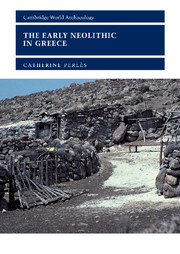Refine search
Actions for selected content:
31 results
Chapter 16 - The Turn of the 7th Millennium in Greece
- from Part III - Aegean and Marmara
-
-
- Book:
- 6000 BC
- Published online:
- 30 April 2022
- Print publication:
- 05 May 2022, pp 261-278
-
- Chapter
- Export citation
Deciphering late Quaternary land snail shell δ18O and δ13C from Franchthi Cave (Argolid, Greece)
-
- Journal:
- Quaternary Research / Volume 80 / Issue 1 / July 2013
- Published online by Cambridge University Press:
- 20 January 2017, pp. 66-75
-
- Article
- Export citation
Saving Costs through the Decontamination of the Packaging of Unused Medical Supplies Using Hydrogen Peroxide Vapor
-
- Journal:
- Infection Control & Hospital Epidemiology / Volume 34 / Issue 5 / May 2013
- Published online by Cambridge University Press:
- 02 January 2015, pp. 472-478
- Print publication:
- May 2013
-
- Article
- Export citation

The Early Neolithic in Greece
- The First Farming Communities in Europe
-
- Published online:
- 18 December 2009
- Print publication:
- 04 October 2001
List of figures
-
- Book:
- The Early Neolithic in Greece
- Published online:
- 18 December 2009
- Print publication:
- 04 October 2001, pp ix-xi
-
- Chapter
- Export citation
7 - A case study in Early Neolithic settlement patterns: eastern Thessaly
-
- Book:
- The Early Neolithic in Greece
- Published online:
- 18 December 2009
- Print publication:
- 04 October 2001, pp 121-151
-
- Chapter
- Export citation
12 - Ritual interaction? The miniature world of ‘dolls or deities’
-
- Book:
- The Early Neolithic in Greece
- Published online:
- 18 December 2009
- Print publication:
- 04 October 2001, pp 255-272
-
- Chapter
- Export citation
Index
-
- Book:
- The Early Neolithic in Greece
- Published online:
- 18 December 2009
- Print publication:
- 04 October 2001, pp 344-356
-
- Chapter
- Export citation
Frontmatter
-
- Book:
- The Early Neolithic in Greece
- Published online:
- 18 December 2009
- Print publication:
- 04 October 2001, pp i-vi
-
- Chapter
- Export citation
2 - The Mesolithic background
-
- Book:
- The Early Neolithic in Greece
- Published online:
- 18 December 2009
- Print publication:
- 04 October 2001, pp 20-37
-
- Chapter
- Export citation
Contents
-
- Book:
- The Early Neolithic in Greece
- Published online:
- 18 December 2009
- Print publication:
- 04 October 2001, pp vii-viii
-
- Chapter
- Export citation
4 - Foreign colonists: where from?
-
- Book:
- The Early Neolithic in Greece
- Published online:
- 18 December 2009
- Print publication:
- 04 October 2001, pp 52-63
-
- Chapter
- Export citation
Introduction
-
- Book:
- The Early Neolithic in Greece
- Published online:
- 18 December 2009
- Print publication:
- 04 October 2001, pp 1-8
-
- Chapter
- Export citation
5 - The earliest Neolithic deposits: ‘aceramic’, ‘pre-pottery’ or ‘ceramic’?
-
- Book:
- The Early Neolithic in Greece
- Published online:
- 18 December 2009
- Print publication:
- 04 October 2001, pp 64-97
-
- Chapter
- Export citation
1 - The land and its resources: the geographic context
-
- Book:
- The Early Neolithic in Greece
- Published online:
- 18 December 2009
- Print publication:
- 04 October 2001, pp 9-19
-
- Chapter
- Export citation
6 - The spread of the Early Neolithic in Greece: chronological and geographical aspects
-
- Book:
- The Early Neolithic in Greece
- Published online:
- 18 December 2009
- Print publication:
- 04 October 2001, pp 98-120
-
- Chapter
- Export citation
10 - Craft specialization: the contrasting cases of chipped-stone tools, pottery and ornaments
-
- Book:
- The Early Neolithic in Greece
- Published online:
- 18 December 2009
- Print publication:
- 04 October 2001, pp 200-226
-
- Chapter
- Export citation
3 - The introduction of farming: local processes, diffusion or colonization?
-
- Book:
- The Early Neolithic in Greece
- Published online:
- 18 December 2009
- Print publication:
- 04 October 2001, pp 38-51
-
- Chapter
- Export citation
